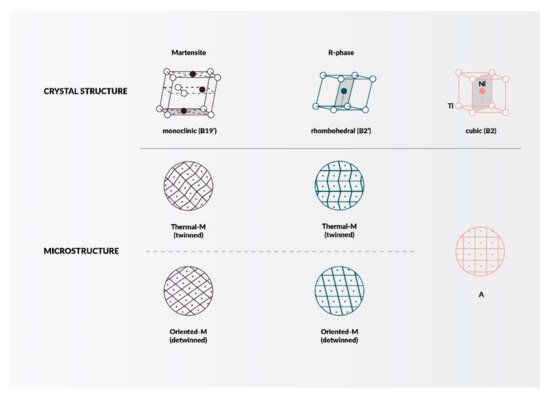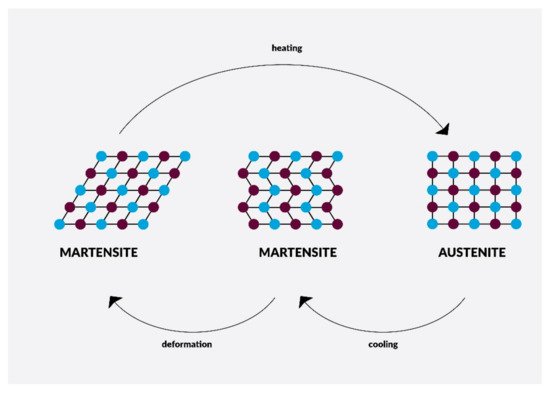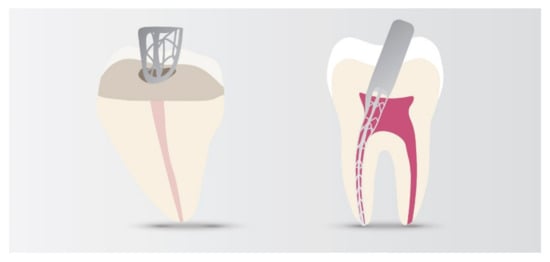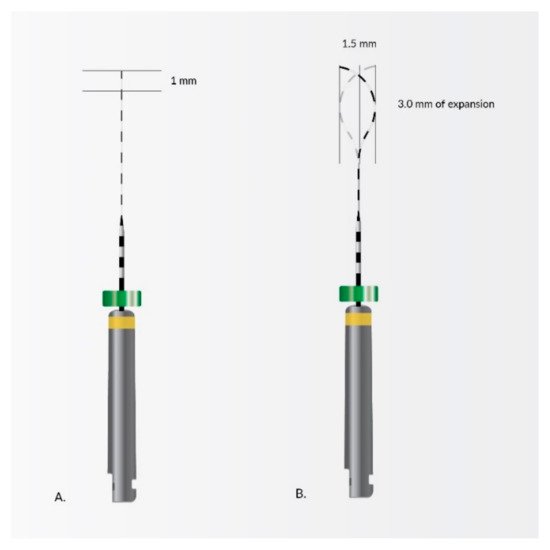The medical procedures in endodontics are time-consuming and mostly require several visits to be able to achieve the proper result. In this field of dentistry, there are still major issues about the removal of the mostly bacterial infection from the dental root canals. It has been confirmed that nanoparticles are much more efficient than traditional materials and appear to have superior properties when it comes to surface chemistry and bonding. Their unique antibacterial properties are also promising features in every medical procedure, especially in endodontics. High versatility of use of nanomaterials makes them a powerful tool in dental clinics, in a plethora of endodontic procedures, including pulp regeneration, drug delivery, root repair, disinfection, obturation and canal filling.
- nanomaterials
- endodontics
- dentistry
1. Introduction
One of the branches of dentistry that deals with the morphology and physiology of the endodontium is endodontics. It combines such aspects of this field as etiology, pathology, epidemiology, prophylaxis and, above all, treatment of endodontic and periapical diseases. Depending on the complexity of the case, the treatment process may be carried out at one or more visits. Due to the difficulty of maintaining the sterility of the operator’s work area, nanomaterials are increasingly used. Thanks to the expanding variety of nanoparticles, such as bioactive glass, zirconia, chitosan, hydroxyapatite, silver particles, zinc oxide, the properties of materials used in dentistry, such as durability, tissue regeneration and bactericidal properties, can be improved.
2. Classification of Nanomaterials, Materials Modification
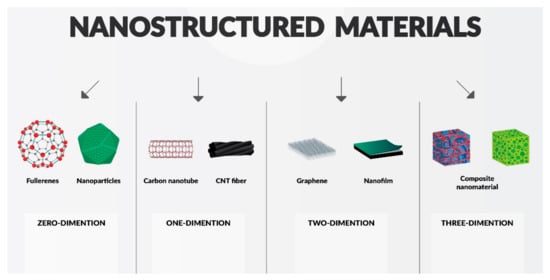
2.1. Quantum Influence on Nanomaterials
2.1.1. Quantum Confinement Effects
2.1.2. Surface Effects
Nano-sized materials have novel characteristics that are absent in the behavior of molecules forming a bulk [29,30,31][7][8][9]. When the number of molecules in the nano-scale is reduced, the materials usually reach a point at which the whole substance starts to behave in a way which is more characteristic for molecules than for a bulk matter. To understand the thermophysical properties of nanomaterials better, theoretical research is required [32,33,34,35,36][10][11][12][13][14]. The general rule is that mechanical and thermodynamic parameters are reduced with decreasing size of particles. Among many features, it applies to Young’s modulus [37][15], mass density [38][16], cohesive energy [39,40][17][18] and melting point [41,42,43][19][20][21]. Macroscopic thermodynamics does not apply to nanomaterials because of the differences in the binding energy that affects them. As L. D. Gelb et al. [44][22] confirmed that phase transition is less visible in nano-phase than in macro-phase. Instead of using the concept of ‘phase’, it can be more correct to speak of ‘different structural isomers’ that coexist over a range of temperatures [45][23].2.2. Chitosan Nanoparticles
Chitosan is an organic chemical compound from the group of polysaccharides. This non-toxic biodegradable substance is obtained from the deacetylation of chitin in alkaline media. Sources of this homopolysaccharide are the exoskeletons of arthropods, mollusks and insects. Chitosan is a polysaccharide containing deacetylated units and acylated units. These unit are, respectively: D-gucosamine and N-acetyl-D-glucosamine. Due to its availability in many forms such as hydrogels, capsules or scaffoldings, it of interest as a material for biomedicine [46][24]. In general medicine, it is useful as a bandage mimics the native extracellular matrix, ensuring the appropriate microenvironment of the wound, thus accelerating its healing. In endodontics, chitosan can be used mainly due to its antibacterial properties [47][25], especially against E.faecalis strain [48,49][26][27]. Regarding its unique chemical structure, it has many applications (alike only or as an alternative combine with other natural polymers), such as medical use, cosmetic use, also bio-printing, agricultural and horticultural use [50][28]. In biomedical engineering chitosan nanoparticles are being used in view of physicochemical properties such as, particularity, biocompatibility and sensitivity [51][29].2.3. Hydroxyapatite (HAp)
The naturally occurring mineral form of calcium apatite is hydroxyapatite (HAp). It is mainly obtained from mineral tissue [56][30]. Hydroxyapatite is highly biocompatible due to the fact that HAp is one of the main constituents of dentin. In addition, it can also quickly osseointegrate with the supporting connective tissue (bone tissue). HAp is used in a variety of forms, equally as composites, coatings [57][31] and powders [58][32] for dental fillings in view of these advantages. The high bioactivity of nanohydroxyapatite results from its similarity to bone apatite as well as its strong ion exchange affinity. In addition, its biological properties are determined by the size and morphology of molecules, the type of ionic impurities in the crystal lattice and the Ca/P molar ratio [59,60][33][34], resulting in its hexagonal system crystallization [61][35]. In addition, its biological properties are determined by the size and morphology of the molecules (Figure 2).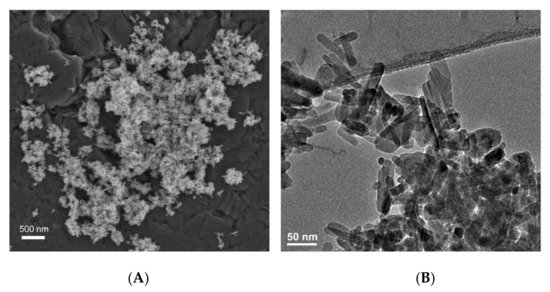
2.4. Bioactive Glass
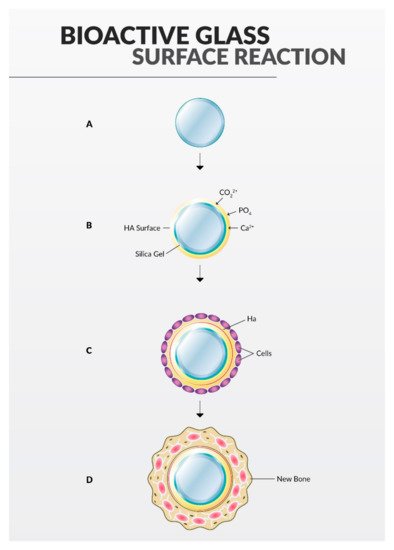
2.5. Zirconia (Zr)
2.6. Nanosilver
2.7. Zinc Oxide (ZnO)
2.8. Exosomes
Various MSCs participate in the process of pulp formation, such as dental pulp stem cells (DPSC), human exfoliated deciduous tooth stem cells (SHED), apical papilla stem cells (SCAP), and dental alveolar progenitor cells (DFPC) [99][49]. Zhou et al. [100][50] proved that microballoons from dental pulp stem cells (DPSCs) can be used in regenerative endodontic therapy due to their pro-angiogenic effect.
2.9. Graphene
Graphene has many properties that can be used in dentistry, including antibacterial activity, potential use of graphene in tissue engineering, dental implants, in the field of endodontics, periodontics and conservative dentistry. Graphene nanoplate exhibits antimicrobial properties due to the sharp edges of GNP flakes piercing the soft cell wall of the bacteria, resulting in their trapping and shrinkage [105][51]. These results suggest that Streptococcus mutans (S. mutans), which is responsible for human caries, can be combated in this way.2.10. Nanopolymers
3. Clinical Applications
3.1. Sealers
3.2. Obturating Materials
Removal of infected tissues from root canal systems, their disinfection and tight filling with proper protection of the tooth crown are the standards of the modern approach to endodontic treatment. After removing the content of the tooth cavity and shaping the canal properly, the root canal should be hermetically filled in three dimensions to prevent being recolonized by microorganisms. Moreover, it provides the isolation of any pathogens from the saliva that are responsible for percolation from the coronal region, the gingival sulcus or periodontal pockets. Only hermetic filling from the coronal orifice to the physiological foramen protects tissues from disease processes, and in the case of existing inflammations, it determines their healing. Obturation is a critical moment and is often the reason why endodontic treatment fails. Several techniques and materials have been developed to provide the cohesive and adhesive interaction of filling materials with the walls of the root canal system. The properties required of perfect filling materials used in endodontic treatment are biocompatiblility with the tissue, stimulation, or at least support of the regeneration of damaged cells, easy adaptation to and removal from the canals, antimicrobial activity, adherence to the canal walls and dimensional stability over time, water insolubility, good handling and flow characteristics, radiopacity, imperviousness and non-porosity, both local and systemic nontoxicity, lack of tooth discoloration, reinforcement, support and strengthening of the root structure as well as affordability and a long shelf-life [132][62]. Currently, despite the advances in materials engineering and molecular biology, no material has been developed that would meet all of these requirements. A wide range of them have been presented over the past decade for root canal filling, from gold and silver cones, gutta-percha, Resilon, calcium phosphate, MTA and various types of sealers. The basic concept of three-dimensional root canal filling involves the use of two materials at the same time—the main one acting as a core with solid or semi-solid consistency, and the other with a semi-solid consistency acting as a sealer, filling the space between the dental wall and the obturating core interface and flowing into multiple canals, fins, deltas, and lateral canals. The most commonly used material for the main filling is gutta-percha. It is used both in cold filling methods including a single gutta-percha cone and lateral compaction, or warm filling methods such as warm vertical or lateral compaction, thermoplastic injection technique, root canal filling with a gutta-percha coated carrier, continuous wave compaction technique. Research shows that gutta-percha alone, even thermoplasticized, does not provide adequate three-dimensional filling and should be used with sealers [133][63]. Gutta-percha is a thermoplastic polymer of natural origin. Chemically it is trans-1,4-polyisoprene and can exist in different crystal forms—alpha and beta—as well as in the isomeric-amorphous gamma phase. In dentistry, the most commonly used form is the beta configuration in the form of a gutta-percha cone, which is stable and flexible at room temperature and is less adhesive and flowable when heated [134][64]. Regarding the lack of true adhesion of GP and consequently microleakage, root canal reinfection, and not enough completed mechanical properties, attempts were made to use additives to improve these capacities [137][65]. Researchers have investigated the medical activity of gutta-percha cones containing different substances including calcium hydroxide, bioceramic, resin, iodoform, zinc oxide, nonthermal plasma-argon, and oxygen plasma chlorhexidine, and cetylpyridinium chloride alone or used in combination [134,138][64][66]. Scientists have also explored nanodiamonds (NDs) and nanosilver particles as an alternative modification to obtain optimum sealing and therapeutic effects [139][67]. Gutta-percha coated with nanosilver particles (AgNPs) exhibited antiseptic properties. After modification, this combination has shown antibacterial activity against E.faecalis, Staphylococcus aureus (S. aureus), Candida albicans (C. albicans) and Escherichia coli (E. coli). In in vitro studies on mouse fibroblasts, Shantiaee et al. [140][68] indicated that this material is biocompatible and has cytotoxicity like standard gutta-percha. In their investigation, it achieved the lowest level of cytotoxicity among the tested materials after one week.3.3. Nano-Size Related Drug Delivery Applications in Endodontics
3.4. Root Repair Materials
Nanotechnology has also revolutionized the way of producing root repair materials. Nanometric particles significantly improved the physical parameters of the material, positively affecting treatment results. Obtaining nanoscale particles enables the design of materials with precise and ultra-fine architecture, which significantly improves the filling properties of the material. Nanoparticles are able to more accurately fit into the complex shape of the tooth canal. Improving the adhesion and tightness of the material used increases the percentage of successful root canal treatment [164,165][71][72]. Root repair materials, due to their biocompatibility, bioactivity and a number of physical features, are used in a variety of dental procedures, for example in endodontics. Mineral trioxide aggregate (MTA) is the first successful material used in treatment. You can use it in many situations in endodontics, such as perforations, root canal treatment, surgical treatment of apex resection. It can also be used for canal filling [166][73]. As described in a study by Mohammed S Alenazy et al. [167][74], the material of choice for backfilling is MTA, but it has long processing and setting times. To overcome these negative properties, studies used MTA in nanomodified particles for improved physicochemical properties. They discovered that when MTA was used in the form of nanoparticles, the surface area was increased for the powder in contact with tooth tissues, which makes setting time shorter and growth the hardness of the material. This change apparently helped MTA solidify faster. Unfortunately, the use of nanomaterials was associated with the deterioration in the required hardness after full setting. Additionally, despite its great recognition, MTA is not without its disadvantages—mainly in terms of biocompatibility, strength, setting time, and biological and physical properties. This limitation seems to be another challenge for nanomaterials in root repair materials.3.5. Nanoparticle-Based Disinfection in Endodontics
4. Nanomaterials in Endodontic Instruments and Their Effects
Nickel-titanium (NiTi) endodontic rotary files are common instruments in dentistry today. Most of those available on the market are clockwise rotating instruments; only a few are counterclockwise-rotated with reciprocation movement, e.g., Reciproc® (VDW, München, Germany), Wave One® (Dentsply Sirona, Charlotte, USA). Practically all of them have a non-cutting tip, except Mtwo Retritment® (VDW, München, Germany), allowing one to file following the axis of the root canal or along the glide path. NiTi rotary files have different cross-sectional shapes which give them special properties. The smaller the cross-sectional area, the more flexible the tool and when the more acute angle at the edge, the cutting is better. Nitinol occurs in two crystalline phases (Figure 4) called martensite and austenite, and sometimes appears intermediate phase—R phase (e.g., Twisted Files). Their transformations (Figure 5) give particular properties, such as shape memory and superelasticity.